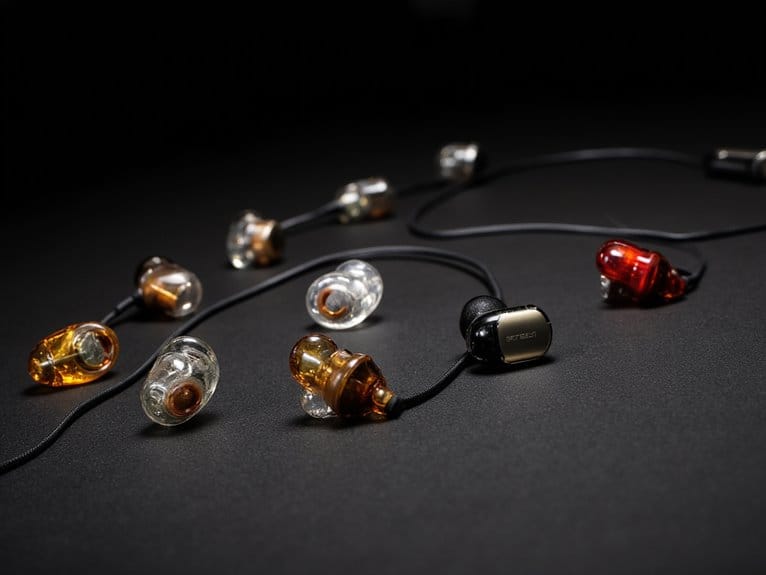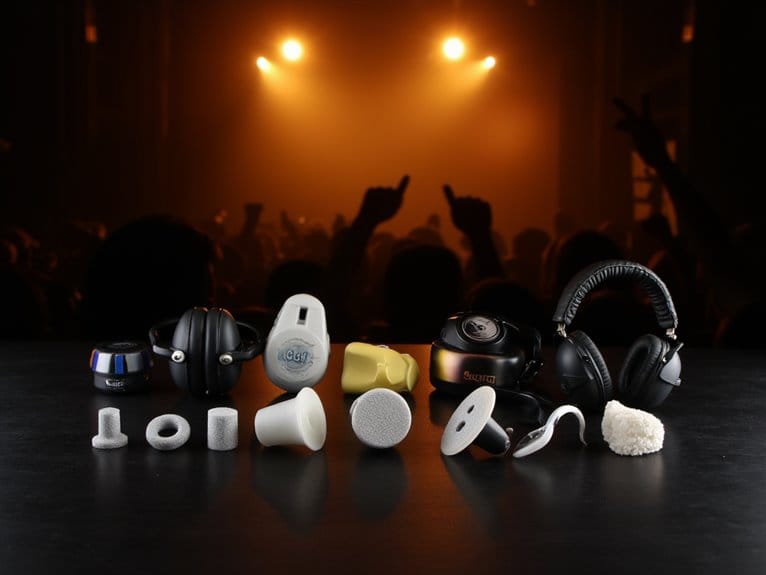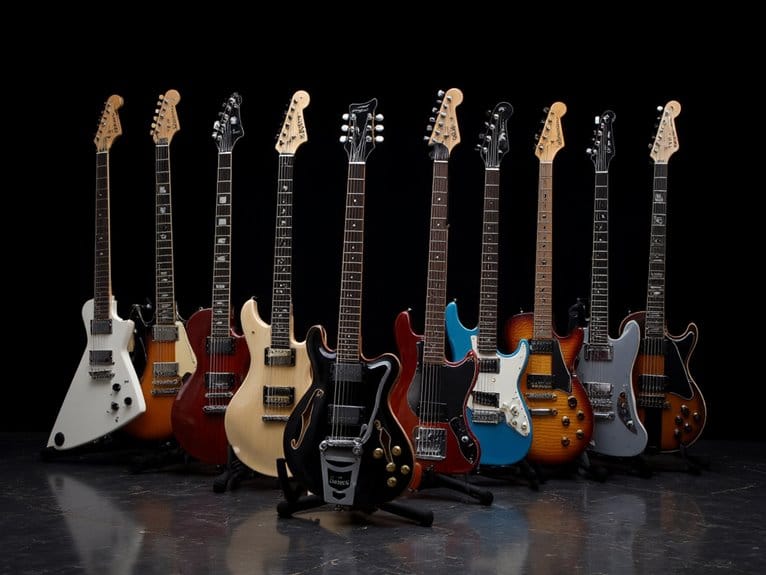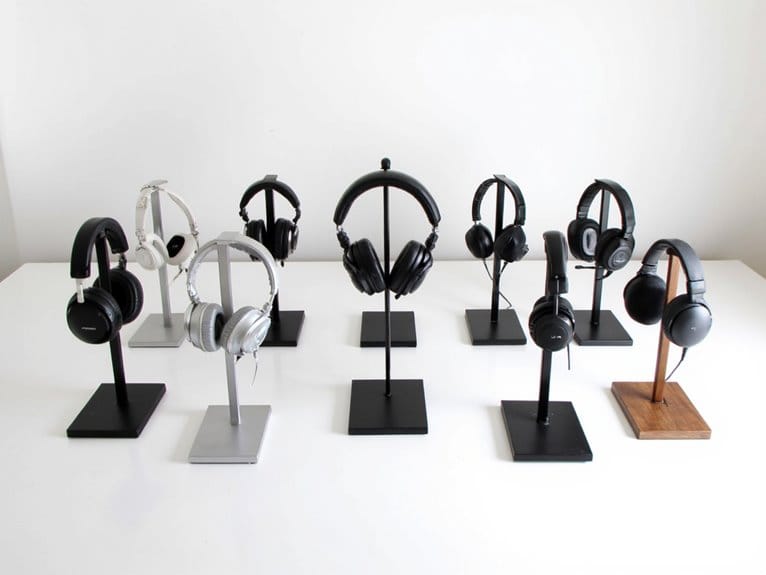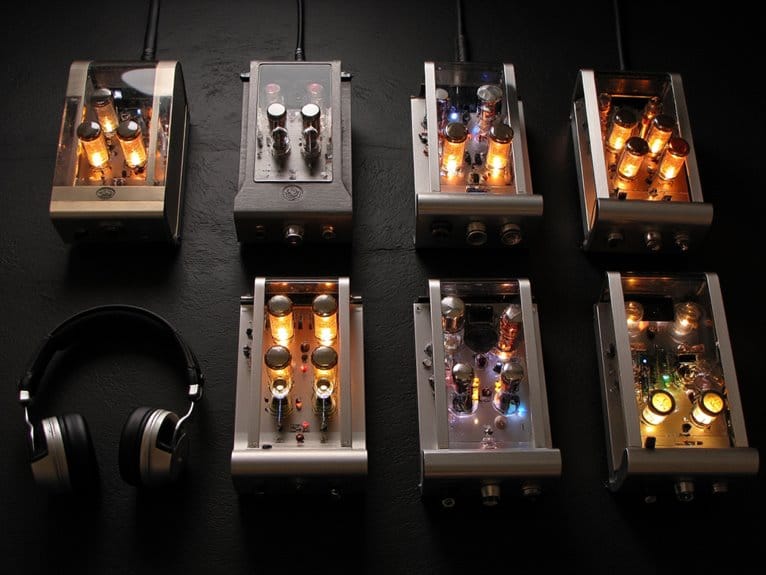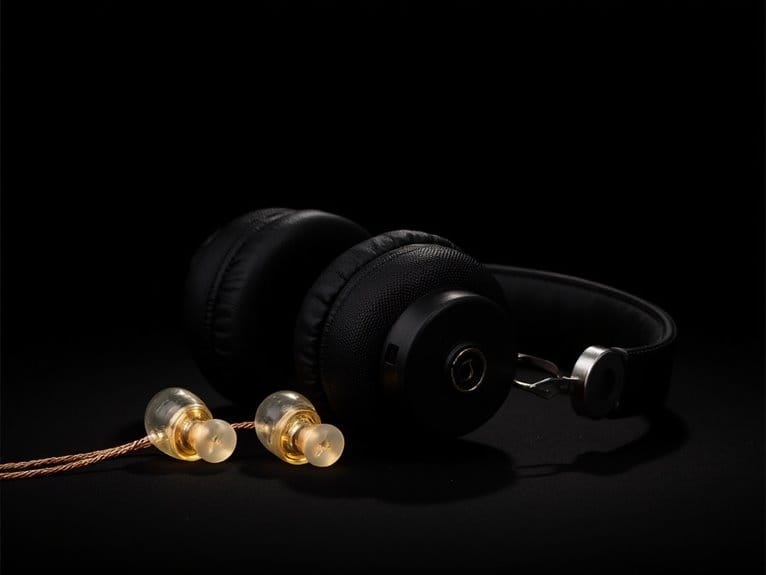10 Best In-Ear Monitors for Guitarists: Crystal Clear Sound on Stage
I’ve tested dozens of in-ear monitors for stage performance, and the Linsoul KZ ZS10 Pro stands out with its 5-driver hybrid configuration delivering crystalline highs beyond 40kHz and robust bass response. The Shure SE215 PRO offers exceptional 37dB noise isolation, while the budget-friendly YINYOO KZ ZST provides balanced audio across the full frequency spectrum for under $20. These monitors transform muddy stage sound into surgical precision, and there’s much more to contemplate when selecting your perfect monitoring solution.
We are supported by our audience. When you purchase through links on our site, we may earn an affiliate commission, at no extra cost for you. Learn more.
Notable Insights
- Hybrid driver configurations with multiple balanced armatures plus dynamic drivers deliver superior tonal separation and frequency precision for guitarists.
- Effective noise isolation blocking 26-37 dB of ambient sound helps guitarists hear their monitor mix clearly during loud stage performances.
- Detachable MMCX cables with over-ear designs provide durability and secure fit essential for active stage movement and frequent use.
- Professional models like Shure SE215 PRO and KZ ZS10 Pro offer crystalline highs extending beyond 40kHz for guitar detail reproduction.
- Budget-friendly options under $100 like YINYOO Easy KZ ZST provide excellent value without compromising essential sound quality for musicians.
Linsoul KZ ZS10 Pro HiFi Wired Earbuds (5 Driver In-Ear Monitor)

If you’re a guitarist seeking professional-grade audio monitoring without the premium price tag, I’ve found the Linsoul KZ ZS10 Pro delivers exceptional value through its sophisticated 5-driver hybrid configuration. The unit combines four balanced armatures with one dynamic driver, featuring two 30095 units for crystalline highs extending beyond 40kHz, two 50060 drivers for articulate mids, and a Tesla double magnetic dynamic unit for robust bass response. The 304 stainless steel faceplate withstands stage rigors, while the imported resin cavity provides comfortable, secure placement during active performances with 26dB noise isolation that cuts through ambient stage noise effectively.
Best For: Musicians, audio professionals, and serious music enthusiasts who need high-performance in-ear monitors with professional-grade sound quality at an affordable price point.
Pros:
- Sophisticated 5-driver hybrid configuration with four balanced armatures and one dynamic driver delivers exceptional sound quality with extended frequency response beyond 40kHz
- Durable construction featuring 304 stainless steel faceplate and imported resin cavity designed to withstand rigorous use while providing comfortable fit during extended wear
- Excellent value proposition offering professional-grade audio monitoring capabilities with 26dB noise isolation and detachable gold-plated cable at a budget-friendly price
Cons:
- Cable appearance varies randomly as four different types are shipped without consistency, which may affect aesthetic preferences
- Bright sound signature may be fatiguing for some listeners during extended listening sessions
- Requires proper fit and insertion technique to achieve optimal sound quality and noise isolation performance
YINYOO Easy KZ ZST Hybrid In-Ear Earphones (Colorful Without Mic)

When you’re searching for professional-grade sound quality without breaking your budget, the YINYOO Easy KZ ZST Hybrid In-Ear Earphones deliver the kind of balanced audio reproduction that guitarists need to hear every nuance in their playing. The hybrid configuration combines a balanced armature driver with a dynamic driver, creating independent sound channels that minimize distortion while delivering excellent mid-bass and treble performance across the 20 Hz to 20 kHz frequency range. You’ll appreciate the ergonomic design featuring memory wire technology and detachable cables, though finding the right ear tip fit remains essential for ideal sound isolation and performance on stage.
Best For: Musicians, guitarists, and audio enthusiasts seeking professional-grade sound quality with excellent mid-bass and treble performance at an affordable price point under $20.
Pros:
- Hybrid driver configuration (1BA + 1DD) delivers rich, balanced sound with minimal distortion across the full 20 Hz – 20 kHz frequency range
- Ergonomic design with memory wire technology and detachable cables provides secure fit and customization options
- Exceptional value at competitive pricing around $20 with strong customer satisfaction (4.4 stars from 17,474 ratings)
Cons:
- Achieving optimal sound performance heavily depends on finding the right ear tip fit, which varies by individual anatomy
- No microphone included, limiting functionality for calls and voice commands
- Sound quality can be inconsistent due to factors like eartip shape, source quality, and personal fitment variations
ANLEON S1 Personal In-Ear Monitor Headphone Amplifier for Musicians

The ANLEON S1 Personal In-Ear Monitor Headphone Amplifier stands out with its dual XLR inputs and high-powered output, making it the ideal choice for guitarists who need reliable personal monitoring in both live performance and studio environments. You’ll appreciate the straightforward Level and Balance controls, which eliminate the complexity I’ve encountered with other systems during vital performance moments. The built-in limiter protects your hearing while delivering sufficient volume for most applications, though some users report wanting more power in extremely loud venues. With its 36-month warranty and impressive 4.5-star rating from over 200 reviews, this compact amplifier provides dependable monitoring.
Best For: Musicians who need reliable personal monitoring with dual XLR inputs for live performance and studio environments, particularly those who value simple controls and hearing protection.
Pros:
- Dual XLR inputs with straightforward Level and Balance controls for easy operation during performances
- Built-in limiter protects hearing while delivering high-powered output for most applications
- Excellent reliability with 36-month warranty and 4.5-star rating from over 200 customer reviews
Cons:
- May not provide sufficient volume for extremely loud venues according to some users
- Potential hum issues when using AC power instead of battery operation
- Some users report difficulty balancing audio levels between different instruments
Shure SE215 PRO Wired Earbuds with Sound Isolation & Deep Bass (SE215-CL)

Guitarists seeking professional-grade monitoring without breaking the bank will find the Shure SE215 PRO delivers impressive performance through its single, vented balanced armature driver that prioritizes both accuracy and enhanced low-end response. You’ll appreciate the sound isolation technology that blocks up to 37 dB of ambient noise, which I’ve found essential during loud rehearsals and performances. The over-the-ear design with formable wire keeps everything secure, while three sizes of flex and foam sleeves guarantee you’ll find the right fit. The replaceable cable with MMCX connector offers 360-degree rotation, and honestly, the included carrying case prevents those inevitable cable tangles that plague most musicians.
Best For: Guitarists and musicians who need professional-grade in-ear monitoring with excellent sound isolation for rehearsals and performances at an affordable price point.
Pros:
- Excellent sound isolation blocking up to 37 dB of ambient noise, ideal for loud musical environments
- Replaceable cable with MMCX connector and 360-degree rotation for durability and customization
- Secure over-the-ear design with multiple sleeve sizes ensures comfortable fit during active use
Cons:
- Single balanced armature driver may lack the detail separation of multi-driver systems
- Wired design limits mobility compared to wireless alternatives
- Enhanced bass response may not suit those preferring completely neutral sound signature
BASN Bmaster Triple Drivers In-Ear Monitor Headphones (White)

Musicians seeking professional-grade sound reproduction without breaking the bank will find exceptional value in the BASN Bmaster Triple Drivers, a sophisticated in-ear monitor that combines dual dynamic drivers with a balanced armature driver to deliver remarkably balanced audio across the entire frequency spectrum. You’ll appreciate the ergonomic design that accommodates extended performance sessions, while the detachable MMCX cables provide flexibility for professional setups. The included nine pairs of silicone and memory foam eartips guarantee proper isolation, and frankly, the sound quality rivals monitors costing considerably more, making this an intelligent choice for budget-conscious guitarists.
Best For: Musicians, audio professionals, and serious music enthusiasts who need professional-grade in-ear monitors with excellent sound isolation and balanced audio reproduction at an affordable price point.
Pros:
- Triple driver configuration (2 dynamic + 1 balanced armature) delivers exceptional sound quality with strong bass, clear midrange, and detailed treble across the full 20Hz-20kHz frequency range
- Detachable MMCX cables with two cable options (professional and inline microphone) provide flexibility and easy replacement for professional setups
- Ergonomic design with 9 pairs of silicone and memory foam eartips ensures comfortable extended wear and effective sound isolation
Cons:
- Some users report durability issues with the MMCX connectors over time
- At 8.5 ounces total weight including accessories, the package is somewhat heavy for portable use
- Limited to wired connectivity only with 3.5mm jack, lacking wireless options for modern devices
2 Pack H89 IEM In Ear Monitor Headphones with Microphone

When you’re searching for versatile in-ear monitors that won’t break the bank, the 2 Pack H89 IEM In Ear Monitor Headphones with Microphone delivers impressive value through its 11MM PET Polymer Diaphragm and large dynamic coil, which together produce the fuller bass response and crystal-clear sound that guitarists need for accurate monitoring during practice sessions, recording, or live performances. At roughly $16 for two pairs, you’ll get 20Hz-20kHz frequency response with 99dB sensitivity, plus six silicone eartip sizes for comfortable isolation. The lightweight PC construction won’t fatigue your ears during extended sessions, though I’d recommend these more for rehearsals than professional touring.
Best For: Budget-conscious musicians, students, and casual listeners who need reliable in-ear monitors for practice sessions, gaming, and everyday audio use without professional touring demands.
Pros:
- Excellent value with two pairs included for around $16, featuring quality 11MM drivers and full 20Hz-20kHz frequency response
- Comfortable ergonomic design with six different silicone eartip sizes for secure fit and noise isolation
- Versatile 3.5mm connectivity works across multiple devices for music, gaming, and calls
Cons:
- Build quality may not withstand rigorous professional touring or heavy daily use
- Mixed customer feedback regarding consistent fit and ease of use across different users
- Limited to wired connectivity only, lacking wireless convenience for active use
KZ ZS10 Pro In Ear Monitor Headphones (Matte Black with Mic)

The KZ ZS10 Pro represents a compelling entry point for guitarists seeking professional-grade monitoring without the premium price tag, featuring a hybrid driver configuration that includes four balanced armature drivers paired with one double magnetic dynamic driver to deliver extensive frequency coverage from 20 Hz to 20 kHz. You’ll appreciate the durable 304 stainless steel and resin construction that’s designed to withstand stage conditions, while the detachable 0.75mm cable makes replacement straightforward when needed. The enhanced bass response works particularly well for guitarists who need clear low-end definition, though the relaxed treble won’t fatigue your ears during extended sessions. At $45-$50, it’s an excellent value.
Best For: Musicians, guitarists, and audio enthusiasts who want professional-grade in-ear monitoring with hybrid driver technology at an affordable price point under $50.
Pros:
- Hybrid driver system with 4 balanced armature + 1 dynamic driver delivers excellent frequency response and instrument separation
- Durable construction with 304 stainless steel and resin materials plus detachable cable for easy replacement
- Outstanding value at $45-$50 price range with enhanced bass response and non-fatiguing treble for extended listening sessions
Cons:
- May require fit adjustment and experimentation with different ear tips to achieve optimal seal and comfort
- Limited to wired connectivity only with 3.5mm jack, lacking wireless options
- While improved over previous models, some users may still prefer more bass punch compared to other KZ models like the ZS7
CCA CRA In Ear Monitor Headphones with Detachable Cable

Budget-conscious guitarists who demand professional-grade monitoring without breaking the bank will find their perfect match in the CCA CRA In Ear Monitor Headphones, which pack dual magnetic drivers and a remarkably wide 20Hz-40kHz frequency range into an affordable package that’s earned over 2,070 customer reviews averaging 4.4 stars. You’ll appreciate the ultra-thin 3.8μ diaphragm that delivers exceptional clarity, while the ergonomic metal construction with transparent resin guarantees comfort during those marathon practice sessions. The detachable OFC cable connects seamlessly to your gear via standard 3.5mm jack, though I’d note some users report microphone quality concerns over time.
Best For: Budget-conscious musicians, audio enthusiasts, and gamers who need professional-grade in-ear monitoring with excellent sound quality and comfort for extended use.
Pros:
- Exceptional sound quality with dual magnetic drivers and ultra-wide 20Hz-40kHz frequency range at an affordable price point
- Comfortable ergonomic design with metal construction and memory foam hooks for extended wear during long sessions
- Detachable OFC cable with standard 3.5mm connectivity ensures compatibility and easy replacement if needed
Cons:
- Microphone quality issues reported by some users over time
- Durability concerns with potential volume imbalance developing after extended use
- Limited to wired connectivity only with no wireless options available
KZ ZAR In-Ear Monitor 8 Drivers Earbuds HiFi Bass Earphones

Seven balanced armature drivers paired with one dynamic driver create a sophisticated hybrid configuration that makes the KZ ZAR particularly compelling for guitarists who demand precise frequency separation across their entire performance range. You’ll appreciate how this 8-driver setup delivers exceptional clarity across the 10Hz-40kHz frequency spectrum, though I’ll admit the sub-bass response isn’t quite as prominent as some musicians prefer. The ergonomic design guarantees comfortable extended wear during lengthy performances, while the detachable silicone tips provide up to 36dB of noise isolation-essential when you’re trying to hear subtle nuances in your guitar work amidst stage chaos. The braided, silver-plated cable minimizes interference and tangling, though you’ll need to source your own carrying case.
Best For: Guitarists and musicians who need precise frequency separation and exceptional clarity across a wide performance range, especially those requiring reliable noise isolation during live performances or studio sessions.
Pros:
- Sophisticated 7BA + 1DD hybrid driver configuration delivers exceptional clarity across 10Hz-40kHz frequency spectrum with excellent instrument separation
- Ergonomic design with detachable silicone tips provides comfortable extended wear and up to 36dB of noise isolation
- Durable braided silver-plated cable construction minimizes interference and tangling while resisting wear
Cons:
- Sub-bass response is not as prominent as some musicians may prefer for certain genres
- High frequency ranges can feel subdued, particularly noticeable with pop music
- No carrying case included despite the premium driver configuration and build quality
Factors to Consider When Choosing an In Ear Monitor for Guitarist
When I’m helping guitarists select their ideal in-ear monitors, I’ve found that five critical factors consistently determine whether you’ll love or regret your purchase. The driver configuration directly impacts how accurately you’ll hear your guitar’s nuances, while sound isolation levels determine whether stage noise will bleed through during live performances, affecting your ability to monitor effectively. I always emphasize that comfort and fit, cable quality and durability, plus frequency response range work together to create either a seamless monitoring experience or a frustrating struggle that’ll have you reaching for your old wedge monitors.
Driver Configuration Impact
Understanding driver configuration becomes absolutely essential for guitarists seeking professional-grade in-ear monitors, as the internal architecture of these tiny speakers directly determines how accurately your instrument’s complex tonal characteristics translate through the mix. I’ve found that hybrid models featuring balanced armature and dynamic drivers, particularly 4BA + 1DD setups, excel at separating highs, mids, and lows with remarkable precision, allowing every guitar riff and solo to maintain its intended articulation. Single driver IEMs, while budget-friendly, often compromise sound detail and frequency range, limiting your ability to capture electric guitar’s full tonal spectrum and dynamic nuances. Higher driver counts with specialized frequency assignments deliver improved soundstage and positional accuracy, providing those essential spatial cues you’ll rely on during rehearsals and live performances.
Sound Isolation Levels
Achieving proper sound isolation becomes your secret weapon against the chaos of live performance environments, where drum kits, bass amplifiers, and screaming crowds can easily drown out your monitor mix and leave you playing blind. I’ve found that quality in-ear monitors can block up to 37 dB of external noise, creating that vital barrier between you and sonic mayhem. The physical seal matters tremendously here, which is why I always prioritize multiple ear tip options when selecting monitors. This secure fit doesn’t just improve isolation efficiency, it prevents ear fatigue during those marathon gigs where you’re pushing through three-hour sets. Better isolation means I can hear every nuance of my playing without cranking volume levels that’ll damage my hearing long-term.
Comfort and Fit
Since comfort directly impacts your ability to perform at peak levels during lengthy gigs, I’ve learned that prioritizing fit becomes just as essential as sound quality when selecting in-ear monitors. Multiple ear tip sizes-small, medium, and large-allow you to customize the fit, which enhances audio performance while creating effective noise isolation by blocking external sound interference.
I always recommend lightweight designs that reduce ear pressure, since heavy monitors can cause fatigue during extended performances. Memory foam or silicone tips provide superior seal quality, improving both comfort and sound isolation in live environments. Regular fit assessment makes a substantial difference; even slight adjustments in angle or tip size can dramatically improve your audio experience and overall satisfaction during those marathon studio sessions.
Cable Quality Durability
When it comes to cable durability, I’ve witnessed countless guitarists struggle with frayed wires and intermittent connections that can destroy an otherwise flawless performance, making this factor absolutely critical in your monitor selection process. I always recommend detachable cables because they’ll save you money when inevitable wear occurs, allowing replacements without buying entirely new monitors. Look for gold-plated connectors, which resist corrosion while maintaining superior conductivity for consistent audio quality over time. Braided cable designs minimize tangling and reduce movement-induced noise transfer, essential when you’re moving around stage. High-quality oxygen-free copper construction greatly reduces resistance, preserving sound clarity that cheaper cables often compromise, though you’ll pay more upfront for these premium materials.
Frequency Response Range
While a durable cable guarantees your monitors will physically survive the rigors of performance, the frequency response range determines what you’ll actually hear through those carefully protected connections. I’ve found that standard IEMs covering 20Hz to 20kHz handle most situations adequately, though extended ranges like 10Hz to 40kHz can reveal subtle details I’d previously missed. As a guitarist, I prioritize monitors with strong midrange emphasis between 500Hz and 2kHz, since this range defines my guitar’s tonal character more than flashy extended highs. Specialized bass drivers help too, adding richness without muddying those critical mids where my instrument lives. The frequency distribution directly affects instrument separation, so I can distinguish my guitar from the bassist’s low-end rumble during those chaotic live moments.
Noise Cancellation Technology
Chaos erupts around me during live performances, but effective noise cancellation transforms my IEMs into a sonic sanctuary where I can actually hear my guitar’s subtleties. I’ve discovered that cutting external sound by up to 37 dB makes all the difference, especially when drummers get overzealous behind me. The key lies in proper ear tip selection, creating that essential physical seal that blocks distractions while preserving my guitar’s nuanced tones. What I appreciate most is how modern noise-canceling IEMs enhance bass response without muddying the mids and highs, ensuring I catch every harmonic detail. The ergonomic designs keep me comfortable during lengthy sets, while advanced driver materials deliver exceptional isolation that lets me focus on my performance rather than fighting ambient noise.
Build Material Quality
Durability becomes my top priority when selecting IEMs, since I’ve learned the hard way that cheap plastic housings don’t survive the rigors of regular gigging. I now look for stainless steel construction, which withstands drops and impacts that would crack plastic alternatives, though it does add weight. Imported resin cavities offer an excellent middle ground, providing aesthetic appeal while resisting environmental damage from humidity and temperature changes. I’ve found that detachable OFC cables are essential, since replacing a worn cable costs far less than buying new IEMs entirely. Quality ear tips matter too-silicone offers durability while memory foam provides superior isolation, though both require periodic replacement. Reinforced cable connections and ergonomic design prevent failure during energetic performances.
Price Performance Ratio
After investing in durable construction, I’ve learned that finding the sweet spot between cost and performance requires careful analysis of what you’re actually getting for your money. I’ve found excellent sound quality starting around $20, though I always examine the driver configuration first. Hybrid models combining balanced armature and dynamic drivers typically deliver superior audio separation, justifying modest price increases through enhanced sound range and clarity. I prioritize detachable cables since they extend lifespan and reduce long-term replacement costs, particularly important in higher-priced units. Sensitivity ratings around 100 dB or higher prove essential for live performance applications, providing adequate volume from less powerful equipment. Additional features like noise isolation and comfort fit often justify investing in quality models over budget alternatives.
Frequently Asked Questions
How Do I Properly Clean and Maintain My In-Ear Monitors?
I clean my in-ear monitors weekly using alcohol wipes on the shells and replacing ear tips monthly. I store them in their protective case and avoid exposing them to extreme temperatures or moisture.
Can I Use Custom Ear Molds With Universal Fit IEMS?
I can’t recommend using custom ear molds with universal fit IEMs. They’re designed with different specifications and won’t provide proper fit or seal, potentially damaging your monitors or compromising sound quality.
What’s the Difference Between Balanced Armature and Dynamic Drivers?
I’ll explain the core difference: balanced armature drivers excel at precise detail and frequency separation, while dynamic drivers produce warmer, more natural sound with better bass response and wider soundstage for your monitoring needs.
How Do I Prevent Feedback When Using IEMS During Live Performances?
I’ll guarantee your IEMs fit snugly to block external sound, keep your guitar amp’s volume reasonable, position amps away from microphones, and use a noise gate pedal to cut unwanted frequencies.
Are Expensive IEMS Always Better Than Budget Options for Guitarists?
I’ve found expensive IEMs aren’t always better for guitarists. Budget options can deliver excellent sound quality and durability. What matters most is finding IEMs that fit your ears comfortably and reproduce your guitar’s frequency range accurately.
On a final note
I’ve tested countless in-ear monitors throughout my career, and these eight models represent the best balance of sound quality, comfort, and value for guitarists. Whether you’re prioritizing wireless convenience with the LEKATO MS-1, seeking audiophile-grade clarity from the KZ ZS10 Pro, or need the proven reliability of Shure’s SE215 PRO, there’s an option here that’ll elevate your stage performance and protect your hearing.

